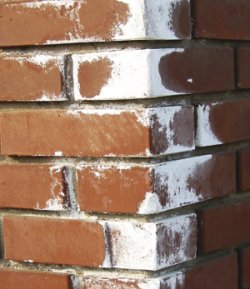 In the walls of clinker brick for practical or aesthetic reasons, it is important to cover the joints in this way, that rain waters flow freely on the wall, and they did not lie in the welds. Hence the need to properly shape them with a concave arch. After pressing the mortar into the joint, it should be profiled – preferably with a piece of rubber tube with the right diameter. At welds of a thickness 1-1,2 cm will suit a piece of rubber hose for watering the garden.
In the walls of clinker brick for practical or aesthetic reasons, it is important to cover the joints in this way, that rain waters flow freely on the wall, and they did not lie in the welds. Hence the need to properly shape them with a concave arch. After pressing the mortar into the joint, it should be profiled – preferably with a piece of rubber tube with the right diameter. At welds of a thickness 1-1,2 cm will suit a piece of rubber hose for watering the garden.
Clinker joint
Due to the aesthetics, all clinker brick walls are built on the so -called. empty joint. You need to use a glass of welds to cover after bricklaying, with narrow long blades. A special help can be a special help with the edges rolled up on two sides. It is easy to slide the mortar from the flat sides without the edge and press it into the horizontal weld. In the vertical welds, press the mortar through the narrow gap left in the corner between the two wipe.
Cover panels
Modern corner and asymmetrical acrylic bathtub. They replace traditional installation with ceramic elements, e.g.. bricks and covering with wall tiles. Such a panel slides under the edge of the tub set and mounted to the walls and spreads between the edge and floor by unscrewing a few screws distributed over the length of the lower edge of the panel.
Tuna
Already at the stage of making the ceiling you have to think about such a structure, so that it is possible to put the bathtub in the hole and base its bottom on a lower part of the ceiling. The bathtub is generally allowed to a depth of half of its height, and then the low platform frames around the bathtub. Using the bathtub installed in this way is also really very convenient for the disabled.